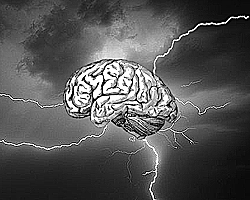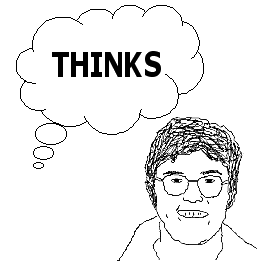 So it turns out consciousness really is an electric buzz around the brain.
So it turns out consciousness really is an electric buzz around the brain.
JohnJoe McFadden claims his conscious electromagnetic field information (CEMI) theory – which says that consciousness lies in the brain’s electromagnetic field – has now been borne out by a number of recent research findings. His paper is in the JCS, but a pdf can be accessed at Machines Like Us. We first discussed the CEMI theory eight years ago (can it really be that long?).
The case for CEMI is based in turn on the idea that synchronous neural firing can be shown to correlate with conscious awareness. Others have thought that lots of neurons firing in harmony at the right frequencies might be important of course; but the CEMI theory explains why it should be important by suggesting that synchronous firing produces effects in the endogenous magnetic field, which unsynchronised activity does not. If registering in that field is taken to be the same as presentation to consciousness we have a neat account of the phenomenon.
The first of the new studies quoted by McFadden, by Fujisawa et al, showed that fields of the kind generated by gamma oscillations in a slice of rat hippocampus affected the neuronal firing pattern. This demonstrates that neurons can influence each other significantly by electromagnetic means quite separate from ‘normal’ synaptic activity. The second, by Frohlich and McCormick, showed broadly similar influences of electromagnetic fields in the visual cortex of ferrets, supporting the claim that the endogenous fields provide a positive feedback loop that helps set up oscillatory networks. The third is research by Anastassiou et al which showed that neurons could influence each other through electric field effects: we discussed this ‘ephaptic coupling’ and pointed out its relevance to McFadden a couple of years ago (you read it here first, folks!).
So there’s the evidence; what does it actually mean? I think McFadden is right to claim that the evidence for electromagnetic field effects on neuron firing is now too strong to ignore. At a minimum, it’s something brain simulations will need to take into account. It’s likely, moreover, that rather than simply being a nuisance factor, it actually plays some functional role in how networks of neurons are recruited and operate together. Anything more? McFadden suggests it may solve the binding problem; I’m not so sure. The binding problem is essentially the question of how information flows from different senses, processed at different speeds, with lags and gaps, somehow manage to end up in a smoothly coherent perception of reality with no jumps or lip-synch problems. Solving that problem may well involve bringing the activity of different neural assemblies together, but to me it’s not clear how field effects could do anything other than smoosh all the inputs together, which is almost the opposite of what we want.
Speculatively McFadden suggests the EM field might be doing field computing, whatever that may be. He quotes a bizarre finding from the School of Cognitive & Computing Sciences (COGS) group at the University of Sussex. They used an evolutionary approach to develop a network which could perform a certain task, and then deleted the nodes which weren’t playing any part in the the final network. Weirdly, they found that one of the essential nodes was not actually connected to anything; yet removing it made the network stop working; put it back and the network worked again. They concluded that electromagnetic coupling must be playing a part. Of course electromagnetic effects in a field-programmable gate array (the equipment used by COGS) are not particularly likely to be anything like electromagnetic effects in the radically different physical substrate of neuronal tissue, but it does illustrate the general principle.
I still don’t see that there are particularly good reasons to say that the EM field is the home of consciousness. For one thing consciousness is full of very complex content: while I can easily see how that complexity could be encoded in the fantastically complex patterns of neuron firing which go on in the cortex, it’s harder to think that the EM field has a sufficiently elaborate structure. My consciousness is (in places) quite sharply defined and multi-layered, whereas a EM field seems more likely to provide a misty general glow. Perhaps the neurons provide the content and the EM field the subjectivity?
But one thing McFadden’s theory cannot be is a solution to the ‘Hard Problem’ of subjective experience; his electromagnetic consciousness is playing a vital functional role in the operation of the brain, whereas qualia, strictly defined, have no causal effects. So much the worse for the theory of qualia, you might think; that just helps show that Dennett was right and the whole business of qualia is nonsensical. However, Sue Pockett, whose electromagnetic theory of consciousness is a kind of cousin of McFadden’s, has jumped the other way on this, accepting that her own electromagnetic consciousness is epiphenomenal: it is produced by the brain but doesn’t in turn produce any effects of its own; consciousness is a mere observer. This enables her to stay in the game so far as the Hard Problem is concerned, but of course it lands her with a different set of problems.
Perhaps in another eight years things will look very different – I rather hope so.



 Oh great. Good to know we’re dealing with hard science again.
Oh great. Good to know we’re dealing with hard science again. Ah – excuse me, but doesn’t it miss the whole point of mystical religious experience (in a typically flat-footed Western materialist way) to explain it as being a lot of radio waves? Isn’t transcendence of the physical something to do with it…?
Ah – excuse me, but doesn’t it miss the whole point of mystical religious experience (in a typically flat-footed Western materialist way) to explain it as being a lot of radio waves? Isn’t transcendence of the physical something to do with it…?